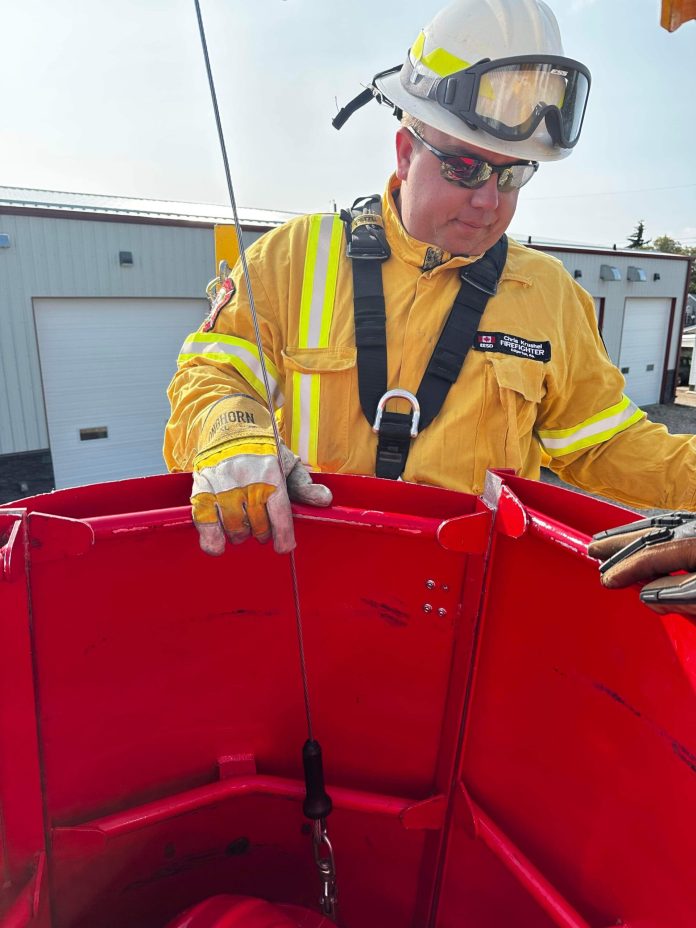
Canadian Agricultural Safety Association
Submitted
Grain entrapments don’t often have happy endings.
Fortunately, that wasn’t the case for a grain entrapment on February 9 in east-central Alberta.
Chris Krushel, fire chief for the Edgerton Emergency Services Department, says a man had entered a grain bin to clean it when he became caught in the grain. Thankfully, another person was present to assist with the work and the auger was shut off. By then, though, the male victim was trapped up to his waist and unable to move.
“The initial responding department, Irma Fire Rescue, did not have the necessary equipment or training. So, we were brought in for additional assistance because they heard that we had just received our grain bin rescue training [through the BeGrainSafe program],” explains Krushel, adding that assistance was also received from Wainwright Fire and Rescue and the fire department from CFB Wainwright.
After an assessment to ensure the male victim was alert and breathing, Krushel says they set up a grain rescue tube around him and used an auger to remove grain near the individual. The man was then able to self-extricate and get down from the bin.
“It was really surprising that he was able to get down under his own power. We weren’t expecting that but it was certainly positive to see,” says Krushel. “This was the first grain rescue we have been involved with, and it occurred right after we did the grain rescue training, so it was very fortunate that everything happened the way it did.”
While this particular grain rescue had a positive outcome, many do not. According to Canadian Agricultural Injury Reporting data, there were 27 fatalities due to asphyxiation from grain or soil on Canadian farms between 2011 and 2020.
Dan Marsellus is fire chief for Kneehill County in Alberta and a master trainer with the Canadian Agricultural Safety Association’s (CASA) BeGrainSafe program. He says that the training offered to firefighters through the BeGrainSafe program, which launched in 2017 due to increased grain entrapment fatalities, is invaluable for saving lives.
“Grain entrapments are high-risk, low-probability events, so knowing how to respond to the situation is essential,” explains Marsellus, who conducted the Edgerton Emergency Services Department’s BeGrainSafe training.
Krushel agrees, noting that the training was extremely beneficial for responding to the February grain entrapment.
“Without the training we would not have had the understanding of what to do and we wouldn’t know how to properly use the grain rescue equipment,” Krushel explains. “The BeGrainSafe training has tested and tried rescue procedures and because of that we knew how to approach the situation and the outcome was fantastic.”
At the core of the BeGrainSafe firefighter grain rescue training is a trailer outfitted with a built- in silo that can hold 7,000 pounds of grain. Positioned above the silo is a platform with a davit arm that can safely lower a person into the grain. Once entrapped, rescue demonstrators use grain rescue tubes in combination with an auger to remove grain from around the individual until they can be safely extracted from the grain.
While the training experience can be intimidating at first, particularly for those who have never been around grain, Marsellus says it also leaves participants with a new perspective and awareness for the risks associated with grain.
“Anyone who goes in the grain is stabilized the entire time and safe, but their eyes get very big when the floor disappears beneath them and they get that sinking feeling. Then they are basically cemented in place and cannot move,” explains Marsellus. “The training highlights the reality and severity of these situations and it really grounds people.”
Krushel adds, “We are in a rural community, but a lot of our department’s members aren’t farmers so this training is a real eye-opener for all that is involved with grain entrapments. Because there are a lot of things included that you wouldn’t even think about until you do this training.”
One significant takeaway for many who participate in the BeGrainSafe training is the realization of how grain flows and that it acts like quicksand, quickly pulling a person down.
“People often think you can swim in grain but you can’t because there is no buoyancy factor in grain. Grain moves very quickly and it is startling how quickly a person can disappear; they can be pulled in under the grain before they even have a chance to say the word ‘stop,’” says Marsellus.
“The grain puts so much force on a person that once the grain is at their hip level, it will literally pull the person in half if we even attempt to pull them out. With that much force, if someone is buried, you want to be as quick as possible to get them out.”
Of course, training participants aren’t the only ones with misunderstandings about grain. That’s why the BeGrainSafe program is not only committed to raising awareness about the hazards of grain and the gravity of entrapments among first responders, but also the general public.
“The best way to save lives is for grain safety to be a proactive issue on farms rather than a reactive issue. The more awareness we have, the more we can hopefully make people realize the need to take grain safety seriously and have those important conversations,” Marsellus says. “Because the moment someone is gone under the grain, it’s irreversible.”
As the February 9 grain rescue demonstrates, having the right knowledge and equipment to respond to these incidents can make a tremendous difference. With more awareness and training, we can hopefully lessen the occurrence of tragic outcomes.
“You may not need to use this training often, and hopefully you don’t,” says Marsellus. “But when responding to a grain entrapment event, it can make all the difference.”
To learn more about CASA’s BeGrainSafe program, visit casa-acsa.ca/BeGrainSafe.

